Super Nintendo
Top 10 Best Super Nintendo Entertainment System Games of All Time!
The Nintendo Entertainment System saved the entire industry from the brink of collapse, and the Super Nintendo Entertainment System helped usher in a new generation of games. Popular franchises like Mario, Zelda, and Metroid were given next generation updates, while new titles like Super Mario Kart and StarFox offered experiences beyond what the 8-bit era could deliver. The Sega Genesis put up a good fight during the 16-bit wars, but the SNES easily outsold it and attracted more support from third-party publishers. The 16-bit generation saw the rise of the fighting game genre and represented a high point for 2D platformers and Japanese RPGs. The SNES is widely considered to be the best console of all time, so narrowing its library down to just ten games is a difficult task to say the least.
10
Mega Man X
1993
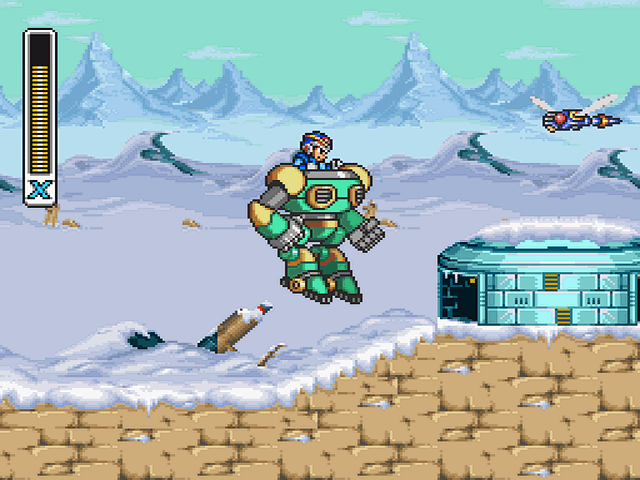
After six NES games that basically looked and played exactly like one another, the Blue Bomber finally got a facelift for his long-awaited debut on the SNES. Like its predecessors, the goal in Mega Man X is to navigate through a series of eight stages that are guarded by diabolical robot bosses. By defeating these bosses, you will gain the ability to use their weapons. In turn, these weapons can be used to capitalize off the weaknesses of your other enemies. Although the basic premise was not changed, X introduced a number of new gameplay elements that helped separate it from previous Mega Man titles. The graphics were obviously enhanced and the soundtrack had more depth, but many of the play mechanics were updated as well. The most significant update was the ability for players to cling to walls to slow their descent or climb to higher ground. The level design is arguably the best in the series, and your actions in one stage can actually affect the environment in others. There is also more reason to explore the levels, thanks to a multitude of hidden upgrades – including the elusive Hadoken power-up that can defeat any enemy in the game with a single shot. Nothing quite beats seeing little Mega Man bust out a classic Street Fighter move. Mega Man X spawned seven direct sequels, but none of them came anywhere close to matching its greatness.
9
Super Mario Kart
1992
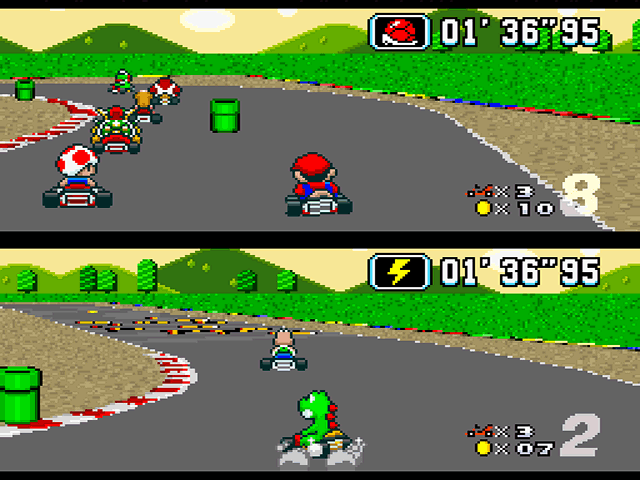
Super Mario Kart was a revolutionary game that essentially created the kart-racing genre. The game featured selectable racers from the Mario universe who each had their own abilities and characteristics. This ensured that no one would have too much of an edge as you raced through the game’s 20 unforgettable tracks. The courses were filled with perilous obstacles and hairpin turns, and they were also loaded with incredible shortcuts. These shortcuts could provide the opportunity for players lagging behind to instantly put themselves back in contention and ensured that the races remained competitive. If the racing elements themselves weren’t enough already, the game also boasted ten weapons to make things even more competitive. Mushrooms gave players a sudden boost of speed, stars granted temporary invincibility, feathers provided the ability to leap over obstacles, and the red turtle shell would seek out and destroy other racers. Perhaps the best aspect of the game was its split-screen which allowed for two people to play at the same time. If racing with a second player got boring, you could also battle them in one of four separate battle arenas. Like Super Mario Bros. before it, Super Mario Kart led to a barrage of uninspired copycats from other developers that failed to live up to the original.
8
Street Fighter II’ Turbo
1993
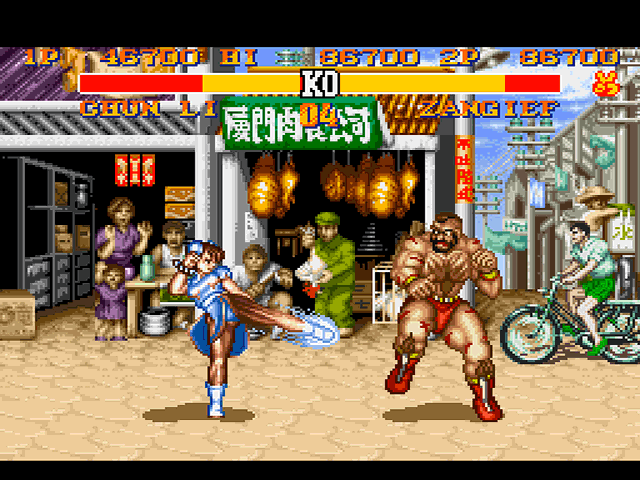
When Street Fighter II was released in 1991, it immediately breathed new life into arcades around the world. Featuring eight diverse playable characters with various strengths and weaknesses, it started the fighting game revolution and inspired countless imitators. The arrival of Street Fighter II on the SNES helped give the console a leg up on the Genesis during the 16-bit wars and was one of the most important games of the generation. Street Fighter II’ Turbo was an updated version of the game, and it was arguably the most balanced version. All of the fighters were given new abilities to ensure that no character had an advantage over another. The ability to perform super moves in the air was a welcome addition, and a faster game engine proved that “Turbo” was anything but a misnomer. When you consider the improved two-player battle mode, adjustable difficulty settings, smarter AI, and the fastest gameplay ever seen in a fighting game, the SNES version was actually superior to the arcade game in many ways. The four new challengers introduced in Super Street Fighter II were welcome additions, but they shifted the perfect balance achieved in Turbo.
7
Super Mario World
1991
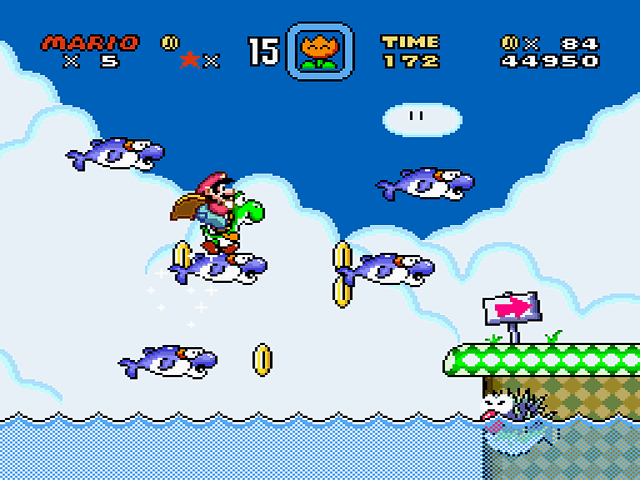
Super Mario World took the winning formula of the Super Mario Bros. series and improved upon it with tighter controls, longer levels, and the introduction of new abilities and items. The game also introduced us all to Yoshi – who added an entirely new dynamic to the series. The ability to save your game allowed for a longer adventure, encouraged exploration, and challenged players to use the large repertoire of special maneuvers in order to finish the game to completion. Multiple exits in levels added more depth to the somewhat linear “point A to point B” level designs the genre was known for. Super Mario World helped launch the 16-bit era and did a nice job of showcasing some of the SNES’s abilities. Multiple background layers, transparencies, oversized sprites, and trippy Mode 7 effects were all effectively demonstrated in the game. Super Mario World was the perfect launch title for the SNES and a worthy addition to the most successful video game franchise of all time. The fact that a timeless classic like Super Mario World is ranked all the way down at #7 speaks volumes about the quality of SNES’s library.
6
Donkey Kong Country 2: Diddy’s Kong Quest
1995
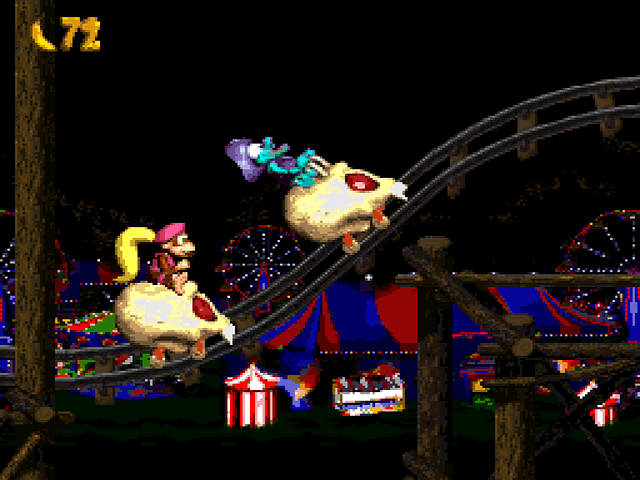
The original Donkey Kong Country dropped a lot of jaws when it was released in 1994 and won many Game of the Year awards. Its incredible pre-rendered graphics blew everyone away and the animation was unlike anything anyone had ever seen on the SNES. Diddy’s Kong Quest didn’t have the same impact, but it improved upon the original in every way. The graphics were even better and featured impressive transparencies and incredible parallax scrolling effects. The music was better and the soaring soundtrack perfectly accentuated the pirate theme. Unlike the other two games in the DKC trilogy, both characters in Diddy’s Kong Quest were fast-moving. The overall pacing of the game was improved as a result, and the levels were a lot more intense. The game as a whole was generally less linear than the original. It had a wider variety of levels, better bonus areas, and even a few hidden stages that were extra challenging. Everything the original did right was improved upon in Donkey Kong Country 2.
5
Super Mario World 2: Yoshi’s Island
1995
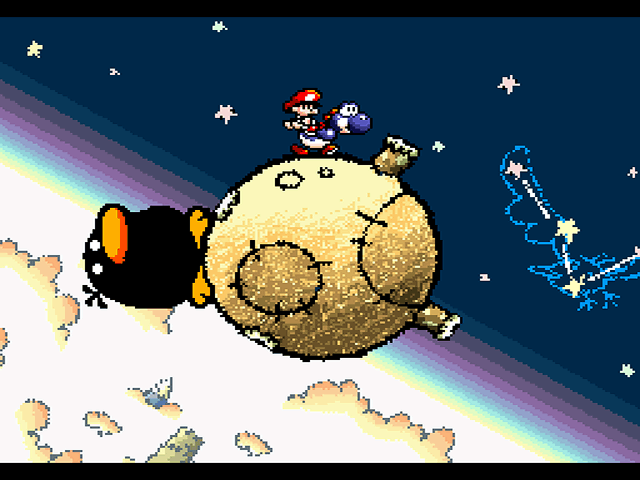
Despite what its title suggests, Yoshi’s Island is not a direct sequel to Super Mario World. Even though it captures the same magic that the Super Mario series did, Yoshi’s Island is a completely original game and one of the most unique platformers ever created. Every one of the game’s 54 lengthy levels offers something different. Whether it’s transforming into a helicopter, skiing down a snow-covered mountain, donning the magic cape as baby Mario, or battling one of the game’s incredible oversized bosses, there is always something exciting waiting around the corner. As impressive as the Donkey Kong Country series was, Yoshi’s Island stands as the most visually-impressive game of the 16-bit era. The game features vibrant colors, incredibly smooth animation, and utilizes the FX-2 chip to produce amazing 3D graphics and innovative “morphmation” effects that put many 32-bit games to shame. Yoshi’s Island took nearly three years to develop and it was even redone from scratch on one occasion, but the long journey was obviously well worth it.
4
Final Fantasy III
1994
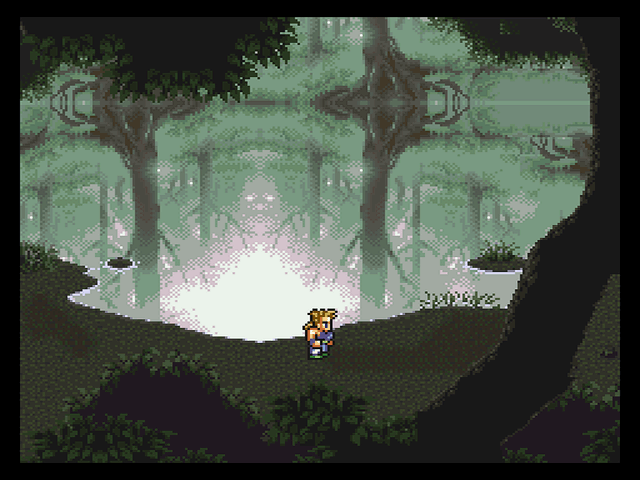
While some light-hearted humor keeps the game from being too depressing, Final Fantasy III is very much a story of tragedy. The central characters are deep and conflicted individuals from different walks of life who are thrown together by necessity. As relationships start developing among the diverse cast members, players are given a sense of who they are and a reason to care about their cause. Some of the characters include: Edgar and Sabin, twin brothers who went in completely opposite directions after the death of their parents; Cyan, a swordsman who carries with him a tremendous sense of guilt after his family and entire kingdom are poisoned by the Empire; a young kid named Gau who has grown up alone in the wild and faces rejection head-on when reunited with his estranged father; and Shadow, a seemingly cold individual who is overwhelmed by shame despite his heroism and whose story is approached with subtlety seldom seen in video games. In time, a story of tragedy transforms into a story of personal redemption as your party becomes energized with an overwhelming sense of optimism in the face of seemingly insurmountable odds. As deep as the characters are, Final Fantasy III never forgets that it’s a game. The diverse cast of characters all have unique abilities that further highlight their individuality. The art design and visuals were breathtaking. As the first console game to feature 256 colors on screen at a single time, it stood head and shoulders over most games of the era. The music was also one of its many highlights, featuring a brilliant score from Nobuo Uematsu that not only sounded great but perfectly accentuated the storyline. There have since been games with better graphics and slicker production values, but in terms of conveying real emotion, Final Fantasy III may very well be the very pinnacle of the 16-bit era.
3
Super Metroid
1994
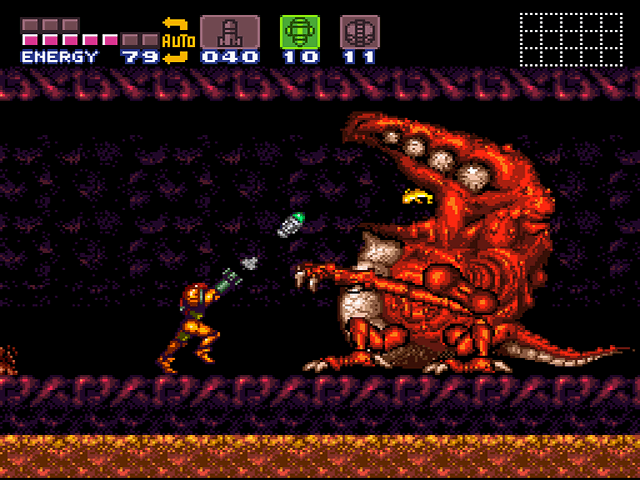
The first thing you’ll notice about Super Metroid is that it looks and sounds amazing. The music conveys a haunting ambience which perfectly accentuates the incredible visuals and works to create a believable and immersive atmosphere. Like the original Metroid, the nonlinear level design provides an expansive world to explore. In fact, some areas were taken directly out of the original Metroid adventure! Once again, in order to access certain areas you will first have to acquire the appropriate power-ups to overcome various obstacles. All the items from the original return (including the trademark morph ball) and new items like a grappling beam and an x-ray visor are introduced. With larger areas to explore, bigger bosses to fight, and new power-ups to find, Super Metroid takes all the things that were great about the original Metroid and makes them even better. Super Metroid is an epic adventure that’s about gameplay, and gameplay alone. Aside from a few paragraphs in the intro, the game contains no dialogue whatsoever. There are no magical fairies or radio messages to tell you where to go next, your enemies don’t discuss their plans in elaborate detail, and there are no drawn-out soliloquies to fill in the blanks for the gamer. The lack of dialogue does not mean there is a lack of a story though. The final boss battle is particularly dramatic and proves that games don’t have to become interactive movies in order to tell compelling stories.
2
The Legend of Zelda: A Link to the Past
1992
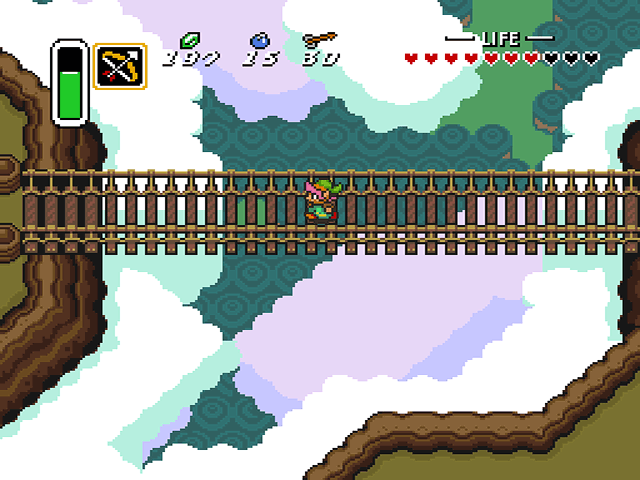
A Link to the Past is a fitting title, seeing as how it brought the Zelda franchise back to its roots with the triumphant return of the overhead view. Visually, the game improves leaps and bounds over its predecessors and successfully creates a fantasy world filled with well-animated characters and colorful environments. From the lighthearted and whimsical sounds of the forests to the haunting theme of the sanctuary, the music perfectly captures the essence of the environment you’re in. The quest is massive and the overlapping Dark World effectively doubles the area to explore. In addition to the massive overworlds, you’ll also have to navigate your way through a dozen of the most unique dungeons the series has ever seen. Each one provides a completely new set of puzzles to solve and new enemies to topple – my personal favorite being a boss who tries to throw you off course by disguising himself as a lost girl. The sheer variety of items to find is impressive, but more important is how the game challenges you to use these items. You’ll use your flippers to meet a hobo under a bridge, knock a tree down by running into it with your Pegasus boots, and reach the other side of cliff tops with the incredibly useful hookshot. The typical “kidnapped princess” routine might be a little cliché, but the massive dungeons, clever puzzles, and memorable characters will keep you motivated until the very end.
1
Chrono Trigger
1995
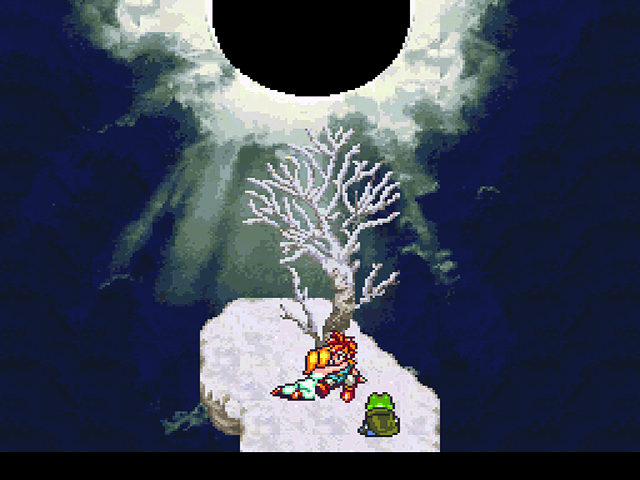
Designed by a “Dream Team” that included the producer of the Final Fantasy series and the director of the Dragon Quest series, Chrono Trigger was destined to be the perfect RPG. The game is perhaps most famous for its creative approach to random battles. Unlike most RPGs, the enemies in Chrono Trigger can be seen on the playing field and can often be avoided altogether. When you are dragged into a battle, the combat happens on the same playing field rather than transporting you to a separate battle screen. The battle system also introduces Double and Triple Techs that allow you to combine the skills of multiple characters to inflict more damage to the enemies. The characters (designed by Akira Toryiama of Dragon Ball fame) are extremely compelling and all have intriguing idiosyncrasies that continue to define them as you progress. The adventure spans millions of years as you attempt to prevent an apocalyptic future, and the time travel element adds a new dynamic to the gameplay. Your actions in past timelines actually affect the outcome of the future! You will encounter a diverse cast of characters on your quest – including a stubborn cave women from the prehistoric era, a medieval knight who has been transformed into a giant frog, and a conflicted robot from the future. Remarkably, the strong writing keeps things grounded and focused despite the seemingly multifarious nature of the characters and myriad of plot twists. Chrono Trigger is less linear than most RPGs and features several optional side quests and over a dozen endings to discover. Visually speaking, the game is absolutely stunning and the attention to detail is amazing. The soaring soundtrack is equally impressive and makes the adventure even more epic. Chrono Trigger is a true masterpiece that’s essentially flawless on every level.

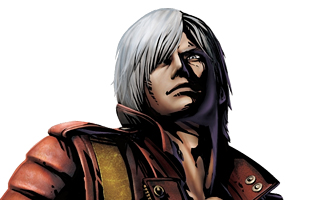
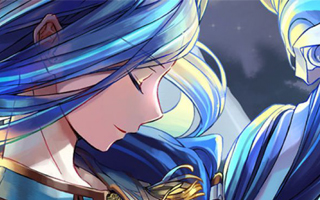
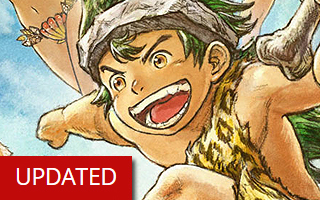
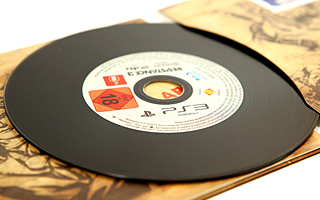
Do you agree with this list? Let us know what you think by leaving a comment below. Your opinion matters!